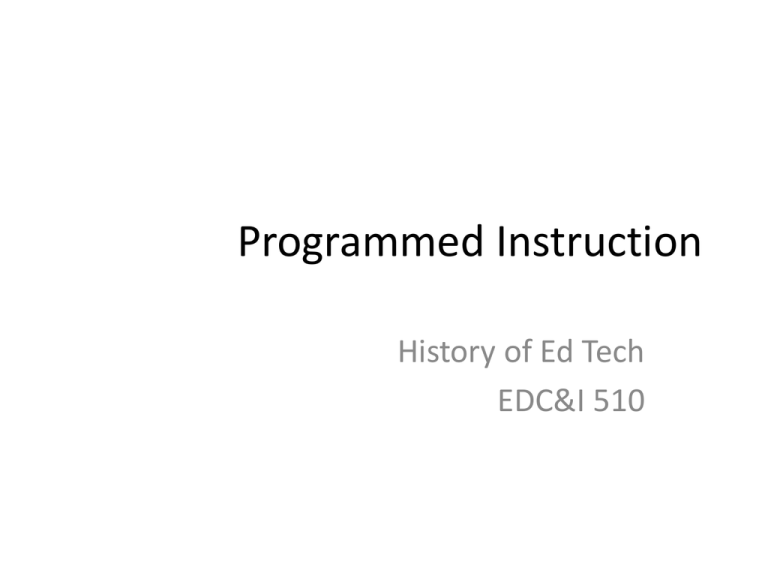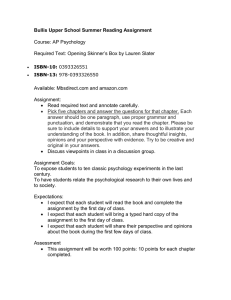What Did We Learn from 70 Years of Research on Instructional Film?
advertisement

Programmed Instruction History of Ed Tech EDC&I 510 Before we begin… (and while your minds are still fresh!) • In small groups, identify two aspects of programmed instruction that are still with us today When we think of PI… • Mostly if people have any association, it’s with B.F. (Burrhus Frederic ) Skinner (1904-1990) Skinner • Skinner was mostly a good guy, and he won significant awards for his thoughtful (many would say philosophical) commentaries of education, learning, and character development Skinner’s Fame • Grew out of classical psychological research on the “operant” – a conditioned (created) response to a particular stimulus • Pigeons, rats were subjects • The “Skinner Box” But… • When he moved from working with animals to working with humans, many became concerned Where Did These Ideas Come From? • Not all unique to Skinner • Beginning around 1900, efforts in psychology to study individual learning, development in a more “scientific” way • Observable behavior became the gold standard (i.e., not “internal states,” “dispositions,” etc.) • WW I drove some efforts – need to test large numbers of people quickly • Also rise of the College Board and attempts to find a common standard for comparing college entrants Edward Thorndike • Educational psychologist at Columbia University Teachers College (18741949) “If, by a miracle of mechanical ingenuity, a book could be so arranged that only to him who had done what was directed on page one would page two become visible, and so on, much that now requires personal instruction could be managed by print. ” (1912) Thorndike’s Image of Learning • Recency – The most recent response will likely govern the next recurrence • Effect – Likelihood of a response recurring is governed by its consequence or effect -> reward or punishment • Exercise – Stimulus-response associations are strengthened through repetition. Sidney Pressey • Educational psychologist at Ohio State U. (1888-1979) • Used the term “testing machine” • “the procedures in mastery of drill and informational material were in many instances simple and definite enough to permit handling of much routine teaching by mechanical means.“ (1926) Advent of the Teaching Machine • Skinner designed and advocated for use of teaching machines to generate more effective learning Key Principles • Immediate reinforcement – Knowledge of whether one got right answer or not; in some cases, more sophisticated feedback • Individual pacing – Learner moved at own speed; classes could be more individualized • Active response – Learner needed to actually do something, not merely read, memorize Many Variations • “Techno-tutor,” “Robo-teacher,” etc. – (Classroom teachers generally hated these terms) • Most worked via one-use paper programs printed on sheets or rolls Quick Up-Take • Caught on in many disciplines, many subjects • Seen as a cheaper way to cope with increasing numbers of students in US schools at the time. • Lots of research conducted on a variety of programming variables • Considerable enthusiasm from military, corporate training community But…. (And it was a very large “but”) • This was RADICALLY DE-CONTEXTUALIZED LEARNING – (And now we know that context makes a huge difference…) • Lack of variety in display and response mechanisms led to rapid boredom by users • The skill required to construct programs was much greater than anticipated, and many were of low quality Later • The move on to “the next device” (TV) in 1960s shunted PI to the sidelines • Rise of computers (Suppes=pioneer) in 70s80s allowed more variety, creation of branching programs, etc. • Rise of cognitive psychology, learning sciences, constructivism (in 90s-00s) made it easier to understand PI’s problems But there was a residue… What Mattered • Decomposition of instruction – Step-wise progression • Active response and immediate feedback • Branching – Led to much stronger focus on individualization of instruction (still with us today) • Behavioral objectives (and specification of learning outcomes) • “Machine learning” (individual interacts with a device) What Didn’t Matter So Much • Precision of steps and type of feedback (large variation with subject and level of learners) • Feedback (didn’t always shape behavior and learning in desired ways) – BUT: Feedback remains a topic of fascination for many researchers and continues to be part of the research on gaming, e-learning, and so on Questions that Faded with Time • Branching – No longer tough to do, but we still don’t always know how • The Behavioral Project – Current “socio-cultural” view of learning = less individual, more nuanced • Can people learn directly from devices? – Sure; but what really grabs ‘em? What Was Left Unanswered • Motivation – Often was not as high as designers assumed • Branching – Value, place of learner control still not resolved, although computers made branching trivial task • Structure of knowledge – Not as precise for many fields as Skinner had assumed • Assessment and feedback – Its place in the overall scheme of learning (part of a larger philosophical debate about purposes of education) The Legacy • We began to get more precise in thinking about what we want as results, outcomes of education (cf. “Backwards Design”) • We began to think about education in terms of learning, not in terms of instruction • We began to think about learning environments in terms of design (rather than simply repetition or enactment of prior patterns) Questions for Discussion • Holland chapter: connection between variables, approaches described there and those used in online or computer-based training today? • Mager: Do we still use “behavioral objectives” today? How/where? How different now? • Suppes: To what extent has his vision for computing in education been realized? Questions for Next Week (10/26) Chu & Schramm • Compared with the research on film, where does the research on TV match up? Where is it different? • What was “conventional instruction” in the studies summarized? • What were some of the underlying motivations for using TV in instruction? Clark (‘83, ’94) • “Mere vehicles…” Do you agree with this position (83, p. 445)? Why or why not? • Media attribute research (p. 451) – Are we still doing this sort of research today? Examples? • Invested mental effort (IME) work (p. 455) – Interaction with student ability levels – implications? • Efficiency vs. effectiveness (94, pp. 25-27) – Do you agree with Clark’s views? • Cf.: McLuhan’s ideas Clark (‘01) • Cognitive load and mental effort (267-279) – Implications for other applications, subjects • How to design to prevent “Overconfidence default” (280-82)? • Motivation processes (“yin” and “yang”) – picture of learners and their motivations that emerges? Salomon & Perkins • Effects with, of, and through technology – Examples of each? • Learning benefits of each? • “Effects through” and notion of activity systems: How does this match with current uses of social media? With support for learning ?











